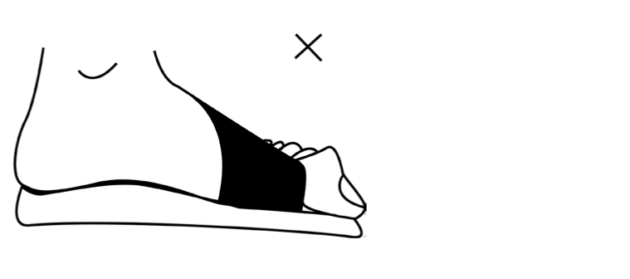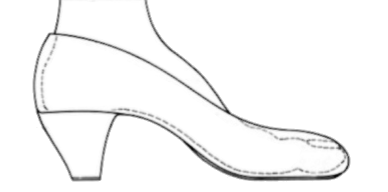What sort of shoe?
Selecting the correct size of your shoes is a basic necessity. However, the size printed on the shoe is less important than how it feels. There should be enough room at the front of your shoe for natural forward movement of your toes during walking or running, but your foot shouldn’t be able to slide about too much (diagram 1).

The sole of the shoe is also important. It should be light, pliable but hard wearing. Materials such as moulded or microcellular rubbers are much better than heavy leather. The sole should be able to bend along a line between the joints of the big toe and the little toe (diagram 1).
Leather uppers are preferred as they stretch and mould to the shape of your foot, unlike synthetic materials, which do not allow your foot to ‘breathe’. People with ‘problem feet’ may find basket weave or stretchy elastane uppers more comfortable. Dark colours and a suede finish disguise misshapen feet. Take care with shoes with seams and decorations around the toe area, as these may irritate and possibly cause callus and corn formation.
Mule type shoes are not recommended for long term use because they have no heel cup and therefore cause a build up of callus around the heel area. They encourage clawing of the toes in order to keep the shoe on the foot (diagram 2).

Court shoes are not advised, as the toes have to act as a buffer to stop the foot sliding forward in the shoe. The higher the heel of the shoe, the more force is experienced in the toe area (see diagram 3).

Lace ups, velcro or buckled shoes are preferable as they fit the foot more firmly and are more supportive than a slip on. Look for shoes that are foot shaped, which allow the toes to wiggle freely.
Ecco, Hotter, Padders and Clarks are all examples of well fitting shoes. If you require a wider, deeper toe box fitting try DB easy b, Cosyfeet or Sandpiper shoes. It is recommended to have your feet measured regularly as foot shape and size can alter (shoes too big can cause as many problems as shoes too small). An easy way to check if a shoe is the right length for you is to take a 1cm wide piece of card, place your foot on it and mark where your heel and longest toe come. Cut the strip to size and place it in your shoe with one end flush to the heel.
Take the card with you when you are buying new shoes.
Ideally, a low-heeled shoe is recommended, but if you have always worn a high heel you will probably find wearing low heels uncomfortable. This is because the tendon attaching the heel to the calf muscle has shortened, so the back of your leg is likely to ache.
Well fitting socks, made from natural fibres (for example, cotton or wool) are recommended, as synthetic materials tend to encourage perspiration.
Be careful of elasticated tops on socks, particularly if you suffer from swollen ankles and feet. Sometimes the seam in the socks and tights can irritate the toes. If so, turn them inside out. A good pair of shoes is only as good as the hosiery that you are wearing. Worn socks with holes etc are likely to cause as much damage.
Never wear shoes without hosiery as you are more likely to develop corns, calluses and blisters due to friction. Worn shoes need replacing.
Children’s shoes
Constriction of the toes is the main cause of deformity in children’s feet. Ill fitting socks and shoes do the damage. In adolescence, fashion shoes cause a lot of damage. Walking barefoot around the house or in sandals helps to exercise the small muscles in the feet. Children’s feet should be measured approximately every six weeks and more frequently if they are experiencing a growth spurt.
Deformities that happen before the age of 10 years due to ill fitting hosiery and shoes may correct themselves naturally as the foot grows, provided correct footwear is worn. Any damage done (and still remaining) up to and during adolescence will be irreversible.
Teenagers’ feet are supple and therefore easily squeezed into shoes too short or narrow without pain. Their feet may grow rapidly, often as much as 1cm in six months, therefore check footwear on a regular basis for good fit.
Safety footwear
See manufacturers instructions if considering wearing insoles within safety footwear.
About the service
People who attend the podiatry services may have been referred by a health professional for a number of reasons. This could be because they are ‘at risk’ from conditions such as diabetes, rheumatoid arthritis or other debilitating illnesses that have affected their foot health.
It may be for foot care advice. Patients may also self refer and these patients may be invited to a:
- foot health talk
- assessment appointment dependent on the reason for referral
If you have any concerns, please contact us.
Please note we do not provide a routine nail cutting service.
Contact Doncaster podiatry foot protection service
Cantley Health Centre
Middleham Road
Cantley
Doncaster
South Yorkshire
DN4 6ED
- Telephone: 03000 211550
- Email: rdash.podiatryreferrals@nhs.net
Document control
This information is correct at the time of publishing
April 2017.
Document reference: DP2810/07.17
Page last reviewed: May 07, 2024
Next review due: May 07, 2025